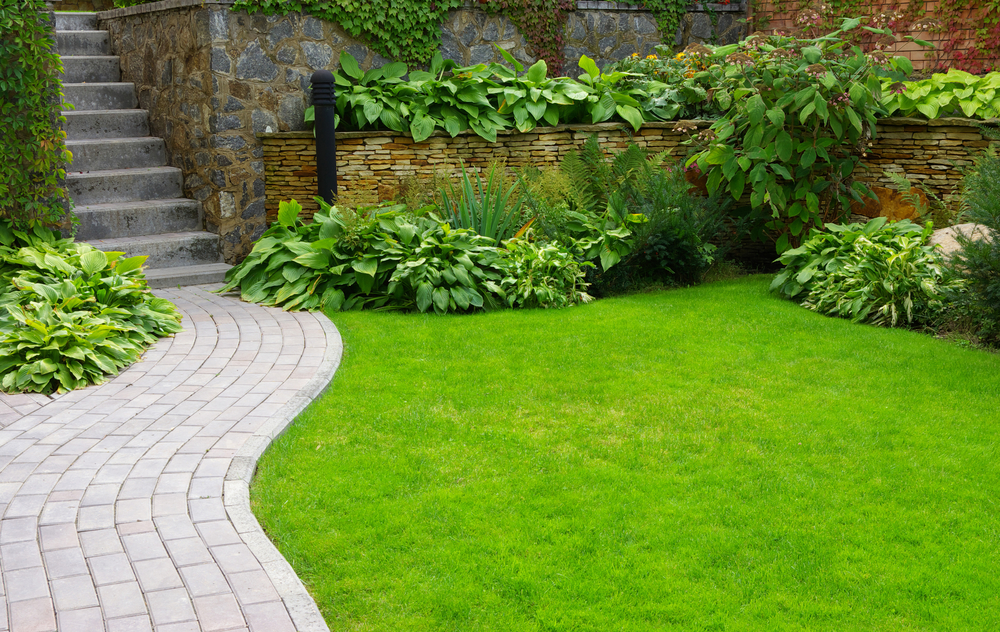Caring for a lawn is much like caring for a child – you must feed it (fertilize), water it, and groom it (mowing). However, there’s one other vital thing that both babies and the grass on your lawn need — air.
This is where aeration comes in.

The primary purpose of lawn aeration is to let your lawn breathe. To be more specific, the soil – as well as the grass’s roots – need some air to give you a lush, green landscape.
Still not sure why you should let your lawn breathe? Here are the five best reasons to aerate the soil, according to landscaping professionals in Chesterfield, MO:
Ease Soil Compaction
Over time, soil in your lawn or garden can become compacted, and this is not a healthy setup for your turfgrass.
This is because compacted soil has smaller spaces between particles that restrict the movement of water and nutrients. Smaller pore spaces also impede oxygen and carbon dioxide from reaching the roots, which makes it more difficult for the grass to breathe, literally.
When this is the case, all the watering and fertilizing you’ve been doing would’ve been for naught since moisture and nutrients don’t reach the grass’s roots anyway. This will result in a weak and thin lawn.
By easing soil compaction, water that would have had to penetrate the soil from a hard, poreless surface can start drenching it from roughly one to two and a half inches underneath. The resulting holes from aeration also hold water and make it more easily accessible to the grass’s roots.
Keep Thatch in Check
Thatch is used to describe the buildup of decomposed plant materials like leaves, roots, and stems on the soil surface. Although a thin layer of thatch may be beneficial, too much can cause a myriad of problems, from pests and disease to unfavorable living conditions for the grass.
In the past, excess thatch (more than half an inch thick) was manually removed using a rake. This process is known as “spiking” and could work, but only for superficial cases.
This is where experts recommend core aeration. Lawns in worse shape have a greater need for core aeration, which allows oxygen to penetrate the thatch layer. This will then stimulate microbial growth that will eventually cause the thatch to decompose.
This process, commonly known as “coring,” is best done in early autumn or late in spring to ensure less thatch accumulation. The higher temperatures during these times of the year promote decomposition better, too.
Improve Root Growth
Deeper roots translate to a healthier lawn. But when the soil is too compacted, the roots cannot dig deeper into the soil, resulting in thinner and less healthy grass.
With aeration, the grass’s roots will have another way to expand – sideways. Two weeks after aerating your lawn, you’ll discover the holes left from coring filled with plant roots poking to the sides. This is where the thicker growths begin.
You see, the roots will take the path of least resistance and will continue to grow down the holes created from aeration and spread out into the surrounding soil. This will then further reduce its compaction.
Another great thing about this is that, as the grass roots proceed with their growth, you won’t need to mow your lawn until late in autumn. Besides, the deeper the roots are, the thicker and more lush your lawn will be.
Reduce Water Runoff
Ever tried watering your lawn only to see the fluid trickle down and run off into the street? If you answered “yes,” then you know what water runoff is.
With aeration, the water that could have run off into the streets will go underground through the holes made from the coring process. The resulting holes look much like tubes that catch the water and keep it in tiny basins, and are tapped by the grass roots as needed.
In short: No water wasted, and fewer irrigation efforts on your side (unless, of course, you have an automatic sprinkler system installed by landscaping pros in Ballwin, MO).
Solve Soil Layering
A lawn that was established by sod is bound to have soil layering, which describes the state of a lawn that has been layered with fine-textured soil over existing coarser soil.
When this happens, drainage is disrupted since water gets caught up in the layer with a finer soil. This will then result in compacted soil conditions, poor root development and, ultimately, an unhealthy lawn.
With aeration, the layering is broken up to allow unhindered water flow, which will also help promote healthier roots.
Aeration Makes Everything Else Easier
With all the reasons above, aeration has become an essential part of lawn care and gardening. When you do this regularly, everything else – from watering and fertilizing to weed and pest control – will flow much more smoothly.
Leave a Reply